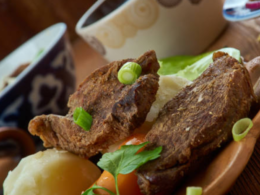First of all, promise not to laugh at me after reading my story. Here’s the story of my first encounter with Chinese cuisine. Now, I’m a proud Nigerian whose taste buds have been trained on the holy trinity of rice, rice, and more rice—jollof, fried, plain, you name it. So, there I was, fresh from a great conversation with a girl I’d just met at an event, and she casually invited me to her family dinner. Plot twist: she’s Chinese. Now, I’m not one to disrespect my ancestors, but I thought, Why not? So I gave a yes!
Ohhhh no! I am not sharing this story (laughs). Rather, let me share the pearls of wisdom I have gathered. For all you international travellers, adventurous souls, and food enthusiasts, diving into Chinese cuisine isn’t just about having a discerning palate; it’s about mastering the dos and don’ts that shape the experience. In this guide, I’ll spill the tea on Chinese dining etiquette, highlighting the need to not only sharpen your dining skills but also grasp the subtle differences between fine dining and the exquisite art of Chinese culinary traditions.
Fine Dining vs. Chinese Dining
Fine Dining: Fine dining is a global concept characterised by exquisite food, impeccable service, and an elegant ambiance. It often follows a multi-course format with meticulous attention to detail in presentation and taste. European and Western influences dominate fine dining establishments.
Chinese Dining: Chinese dining, on the other hand, is a celebration of diversity within a unified culinary tradition. Rooted in thousands of years of history, Chinese cuisine boasts regional variations, flavours, and techniques. Dining is a communal experience, with an emphasis on sharing and a rich menu of dishes presented simultaneously.
Chinese Cuisine
Chinese cuisine is a congenial blend of five key flavours: sweet, sour, salty, bitter, and umami. From the fiery dishes of Sichuan to the delicate dim sum of Cantonese cuisine, Chinese culinary diversity mirrors the vastness of the country itself.
Chinese Dining Skills: Chopsticks and Beyond
Chopstick Mastery
The quintessential skill in Chinese dining is mastering the use of chopsticks. Hold them towards the top, using your thumb, index, and middle fingers. Practice picking up small items, like peanuts, to enhance your dexterity. Never leave chopsticks upright in a bowl of rice, as it symbolises death.
Tea Ritual: Sip with Grace
Tea is an integral part of Chinese dining. Hold the teacup with your index and middle fingers on the edge and your thumb underneath. When someone pours tea for you, tap the table twice with your index and middle fingers as a gesture of thanks. Return the favour by reciprocating the gesture or acknowledging it with a nod.
Lazy Susan
Elizabeth Howell’s innovation is highly popular in China. It’s a spinning table or tray. Rotate it clockwise, allowing everyone a chance to access the array of dishes. Wait for it to come to a complete stop before serving yourself.
Savouring the Soup
Approach soup with grace. Use your spoon to transfer the broth to your bowl, appreciating its aroma before sipping. Refrain from loud slurping, and use the spoon for consuming the solid elements.
Chinese Dining Etiquette
Dining is Communal
Chinese dining is a shared experience. Dishes are placed in the centre of the table, and everyone partakes in the communal feast. Allow elders or hosts to initiate the first bite, and follow their lead when it comes to toasting. When serving, offer to fill others’ plates before your own, signifying a gesture of generosity.
Seniority Matters
Respect for elders is paramount. Again, allow them to start the meal and make the first toast. When receiving or offering a gift, do so with both hands as a sign of respect.
Why You Must Have Dining Skills: A Cultural Passport
Cultural Appreciation
Mastering dining skills is a gateway to cultural appreciation. Understanding the nuances of Chinese dining goes beyond the culinary scene; it deepens your connection to the richness of Chinese heritage.
Dining skills are a universal language. Whether you’re in a bustling street market in Beijing or a Michelin-starred restaurant in Shanghai, your ability to navigate the dining table becomes a form of social currency, bridging gaps and fostering connections.
Dos and Don’ts of Chinese Dining
Dos:
- Use Both Hands: When offering or receiving something, always use both hands as a sign of respect.
- Taste Everything: Even if you’re uncertain about a dish, it’s polite to at least taste a small portion.
- Wait for Elders: Allow elders or the host to start the meal and make the first toast.
- Engage in Toasts: When toasting, hold the glass lower than the person whose toast you’re acknowledging as a sign of respect. When someone proposes a toast, it is customary to respond by taking a sip, offering wishes, and tapping your fingers lightly on the table as a sign of appreciation.
Don’ts:
- Pointing with Chopsticks: Avoid pointing with chopsticks, as it is considered impolite. Use them for their intended purpose—picking up food—and refrain from using them as a tool for indicating directions or objects.
- Stabbing Food with Chopsticks: Avoid stabbing your food with chopsticks, as it resembles a funeral ritual.
- Turning Fish: When served a fish, don’t flip it. The word for “flipping” sounds like “chaos” in Chinese, so it’s considered bad luck.
- Reach Across the Table: Avoid reaching for dishes that are out of your immediate reach; instead, ask for them to be passed.
- Overpower Flavours: When adding condiments or sauces, exercise restraint to appreciate the dish’s original flavours.
- Empty Your Plate: Leaving a little food on your plate is a sign that you’ve had enough. Emptying your plate implies that you’re still hungry.
Conclusion
Take this with you if you don’t remember anything: Chinese dining is not just about what you eat but how you experience it. By sharpening your dining skills, understanding the dos and don’ts, and immersing yourself in the cultural nuances, you not only savour the flavours but also become an active participant in the rich Chinese heritage. Bon appétit—or, as they say in China, “吃饭了” (chī fàn le)!











